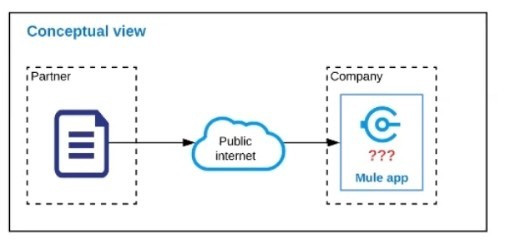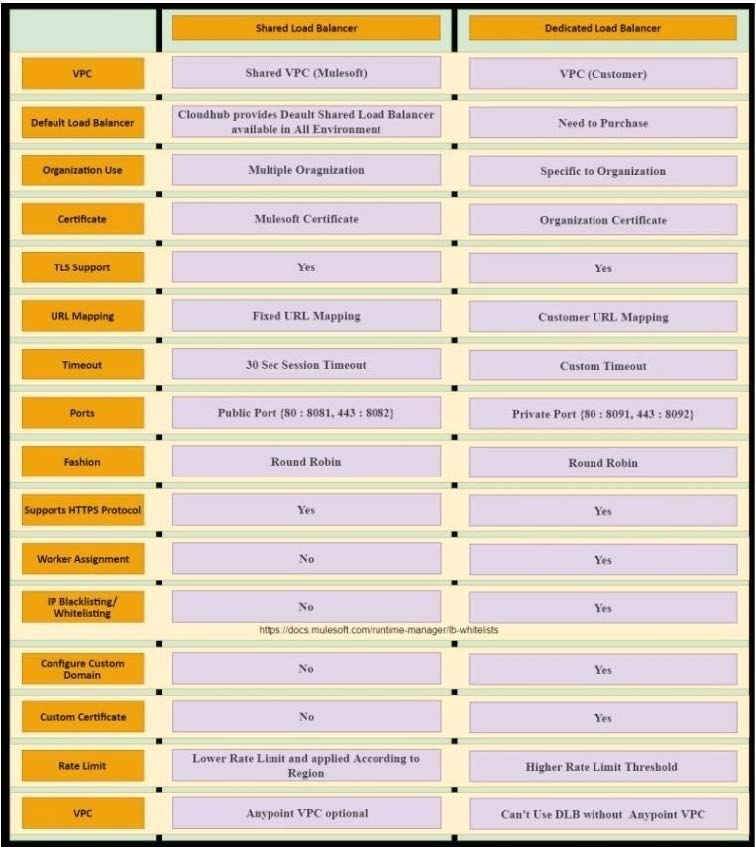Exam Details
Exam Code
:MCIA-LEVEL-1-MAINTENANCEExam Name
:MuleSoft Certified Integration Architect - Level 1 MAINTENANCECertification
:MuleSoft Certified ArchitectVendor
:MulesoftTotal Questions
:116 Q&AsLast Updated
:Jun 01, 2025
Mulesoft MuleSoft Certified Architect MCIA-LEVEL-1-MAINTENANCE Questions & Answers
-
Question 201:
A global, high-volume shopping Mule application is being built and will be deployed to CloudHub. To improve performance, the Mule application uses a Cache scope that maintains cache state in a CloudHub object store. Web clients will access the Mule application over HTTP from all around the world, with peak volume coinciding with business hours in the web client's geographic location. To achieve optimal performance, what Anypoint Platform region should be chosen for the CloudHub object store?
A. Choose the same region as to where the Mule application is deployed
B. Choose the US-West region, the only supported region for CloudHub object stores
C. Choose the geographically closest available region for each web client
D. Choose a region that is the traffic-weighted geographic center of all web clients
-
Question 202:
Refer to the exhibit.
An organization is designing a Mule application to receive data from one external business partner. The two companies currently have no shared IT infrastructure and do not want to establish one. Instead, all communication should be over the public internet (with no VPN).
What Anypoint Connector can be used in the organization's Mule application to securely receive data from this external business partner?

A. File connector
B. VM connector
C. SFTP connector
D. Object Store connector
-
Question 203:
An organization is sizing an Anypoint VPC to extend their internal network to Cloudhub.
For this sizing calculation, the organization assumes 150 Mule applications will be deployed among three(3) production environments and will use Cloudhub's default zero- downtime feature. Each Mule application is expected to be configured with two(2) Cloudhub workers.This is expected to result in several Mule application deployments per hour.
A. 10.0.0.0/21(2048 IPs)
B. 10.0.0.0/22(1024IPs)
C. 10.0.0.0/23(512 IPs)
D. 10.0.0.0/24(256 IPs)
-
Question 204:
An organization is creating a Mule application that will be deployed to CloudHub. The Mule application has a property named dbPassword that stores a database user's password.
The organization's security standards indicate that the dbPassword property must be hidden from every Anypoint Platform user after the value is set in the Runtime Manager Properties tab.
What configuration in the Mule application helps hide the dbPassword property value in Runtime Manager?
A. Use secure::dbPassword as the property placeholder name and store the cleartext (unencrypted) value in a secure properties placeholder file
B. Use secure::dbPassword as the property placeholder name and store the property encrypted value in a secure properties placeholder file
C. Add the dbPassword property to the secureProperties section of the pom.xml file
D. Add the dbPassword property to the secureProperties section of the mule-artifact.json file
-
Question 205:
A customer wants to use the mapped diagnostic context (MDC) and logging variables to enrich its logging and improve tracking by providing more context in the logs.
The customer also wants to improve the throughput and lower the latency of message processing.
As an Mulesoft integration architect can you advise, what should the customer implement to meet these requirements?
A. Use synchronous logging and use pattern layout with [%MDC] in the log4j2.xml configuration file and then configure the logging variables
B. Useasync logger at the level greater than INFO and use pattern layout with [%MDC] in the log4j2,xml configuration file and then configure the logging variables
C. Useasync logger at the level equal to DEBUG orTRACEand use pattern layout with [%MDC] in the log4j2.xml configuration file and then configure the logging variables
D. Use synchronous logging at the INFO DEBUG or Trace level and use pattern layout with [%MDC] in the log4j2.xml configuration file and then configure the logging variables
-
Question 206:
As an enterprise architect, what are the two reasons for which you would use a canonical data model in the new integration project using Mulesoft Anypoint platform ( choose two answers )
A. To have consistent data structure aligned in processes
B. To isolate areas within a bounded context
C. To incorporate industry standard data formats
D. There are multiple canonical definitions of each data type
E. Because the model isolates the back and systems and support mule applications from change
-
Question 207:
Organization wants to achieve high availability goal for Mule applications in customer hosted runtime plane. Due to the complexity involved, data cannot be shared among of different instances of same Mule application. What option best suits to this requirement considering high availability is very much critical to the organization?
A. The cluster can be configured
B. Use third party product to implement load balancer
C. High availability can be achieved only in CloudHub
D. Use persistent object store
-
Question 208:
An organization is designing an integration solution to replicate financial transaction data from a legacy system into a data warehouse (DWH).
The DWH must contain a daily snapshot of financial transactions, to be delivered as a CSV file. Daily transaction volume exceeds tens of millions of records, with significant spikes in volume during popular shopping periods.
What is the most appropriate integration style for an integration solution that meets the organization's current requirements?
A. Event-driven architecture
B. Microservice architecture
C. API-led connectivity
D. Batch-triggered ETL
-
Question 209:
What are two reasons why a typical MuleSoft customer favors a MuleSoft-hosted Anypoint Platform runtime plane over a customer-hosted runtime for its Mule application deployments? (Choose two.)
A. Reduced application latency
B. Increased application isolation
C. Reduced time-to-market for the first application
D. Increased application throughput
E. Reduced IT operations effort
-
Question 210:
An organization is designing a mule application to support an all or nothing transaction between serval database operations and some other connectors so that they all roll back if there is a problem with any of the connectors Besides the database connector , what other connector can be used in the transaction.
A. VM
B. Anypoint MQ
C. SFTP
D. ObjectStore
Related Exams:
Tips on How to Prepare for the Exams
Nowadays, the certification exams become more and more important and required by more and more enterprises when applying for a job. But how to prepare for the exam effectively? How to prepare for the exam in a short time with less efforts? How to get a ideal result and how to find the most reliable resources? Here on Vcedump.com, you will find all the answers. Vcedump.com provide not only Mulesoft exam questions, answers and explanations but also complete assistance on your exam preparation and certification application. If you are confused on your MCIA-LEVEL-1-MAINTENANCE exam preparations and Mulesoft certification application, do not hesitate to visit our Vcedump.com to find your solutions here.
